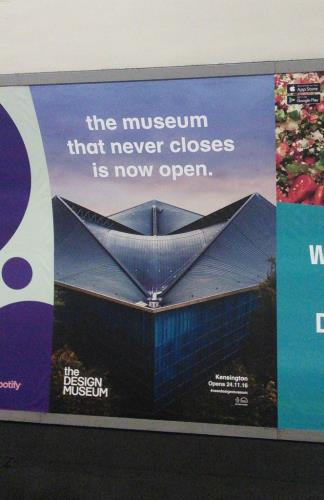Yi-Hsin Lin graduated from SOAS; now living in England as a writer. Lin has participated in the curation of Chinese painting in Victoria and Albert Museum and British Museum. He is also a lecturer in Chinese art at Christie’s Education and contributes to several Chinese-language art magazines.

As everyone expected, the Design Museum, one of the leading museums in London’s creative industries, was finally relocated and re-opened in late November 2016. The architecture of the new museum was designed by the prominent architecture firm OMA, and the interior design was led by John Pawson, a well-known British minimalist architectural designer. Located in Kensington High Street in West London, the museum is just a stone’s throw from other leading arts institutions like the V&A Museum, the Science Museum, the Natural History Museum and the Royal College of Art. As the first museum with a contemporary design theme in the world, the new museum will be on top of the “must see” list among creatives and artists all over the world.
An interactive platform to exchange creative ideas
In 1982, a group of leading designers, including Roy Strong, Terence Conran and Stephen Bayley, held a series of exhibitions in a defunct boiler house adjacent to the V&A Museum to showcase the importance of contemporary industrial design. This had become the renowned “Bolierhouse Project”. Because of the tremendous feedback it had received, the project was relocated five years later to the old warehouses in the south bank of the River Thames, near the Tower Bridge. It had expanded to showcase more exhibits. After that, the designers officially announced that the Design Museum was founded and it would be the first arts institution in the world dedicated to collect, research and showcase contemporary design. Over the last 30 years, the Design Museum has exhibited new and excellent designs in products, fashion, architecture, furniture, graphics and multimedia. The museum has not only made an impact to the public on how they see aestheticism, but has also groomed a lot of creative practitioners who got inspirations from the museum.
With an increasing number of visitors and the scale of exhibition is expanding, the senior management of the Design Museum had been thinking of the possibility of relocation. After years of effort, a plot of land in Kensington High Street was earmarked for the new museum. When the new museum was opened, it was estimated that the number of visitors would reach more than 500 thousands per year. The museum will include areas for one permanent exhibition, two temporary exhibitions and 400sqm of learning spaces. Shops, restaurants and cafés are also included, with the aim of allowing audiences to leisurely visit the museum. Apart from facilities that cater to audiences, the museum has also equipped with studios for designers-in-residence to use, a library, and audio and visual facilities for educational purposes. This is to encourage more professionals in the industry to actively engage in the museum’s activities, and to facilitate interaction between the designers and the museums’ collections.
A thought-provoking museum
To celebrate the opening of the new museum, the organiser held a special exhibition “Fear and Love: Reactions to a Complex World”. The aim is to present different emotions generated amid the rapid changes in the contemporary world, like hope, doubt, frustration and anger. Avant-garde works of 11 leading designers and teams are showcased. They include Hussein Chalayan, Madeline Gannon, Andrés Jaque, Kenya Hara, Metahaven, Neri Oxman and Ma Ke, among others. The exhibition leads an in-depth discussion about a spectrum of controversial topics and trends, like networked sexuality, sentient robots, slow fashion and settled nomads. The exhibition asserts that design is deeply connected not just to commerce and culture but to the sphere of emotions and social environment. This shows that the museum also takes the role of facilitating debates and exchanging ideas by exhibiting thought-provoking works. This not only allows one to rethink the relationship between oneself and others, but also to highlight universal values and multiculturalism.